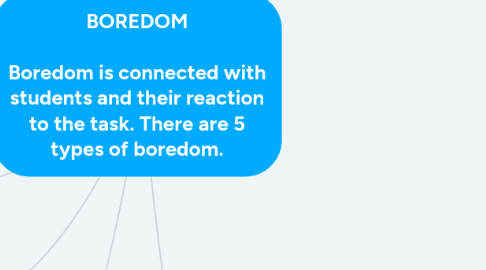
1. Indifferent boredom It relies on low arousal and pleasantly experienced fatigue.
2. Calibrating boredom It is characterized by unpleasant emotions connected with one’s desire and at the same time inability to change the annoying situation.
3. Searching boredom It consists in actively looking for something more interesting to do.
4. Reactant boredom It pertains to individuals who angrily and/or aggressively deflect the blame onto other people and things.
5. Apathetic boredom It is an extremely unpleasant experience of helplessness and dissatisfaction is associated with depression-related characteristics.
6. ENGAGEMENT AND DISENGAGEMENT
6.1. Engagement is the extent to which individuals are actively involved in certain behaviors.
6.2. Disengagement is the act of withdrawing from involvement in an activity or situation because of an individual’s inability to generate interest, pleasure and/ or satisfaction.
7. EMPIRAL PERSPECTIVE OF BOREDOM IN L2 ACQUISITION
7.1. The former’s attitude towards the latter was more predictive of the occurrence of boredom than the activities performed.
7.2. The study about the relationship between general boredom proneness and the actual boredom displayed during practical English classes. was conducted.
7.2.1. The study illuminated the reasons for boredom, such as lack of feedback, poor correspondence between classroom activities and L2 proficiency, the repetitive nature of these activities, the teacher and the choice of student groupings.
7.2.2. The participants’ boredom and motivation were found to fluctuate with a tendency to rise (boredom) and fall (motivation) over time, whereas anxiety remained relatively stable.
8. THE STUDY OF BOREDOM'S LEVELS
8.1. Participants
8.1.1. VARIATION OF BOREDOM LEVELS
8.1.1.1. MBS - students who experience below average boredom in English language classes.
8.1.1.2. HBS - students who experience above average boredom in English language classes.
8.2. Data collection
8.2.1. The background questionnarie This was filled out by the participants in the class preceding the one under investigation and provided information needed for arriving at their profiles.
8.2.2. The Boredom in Practical English Language Classes Questionnaire This was also completed in the class preceding the class in question.
8.2.3. The in-class boredom questionnaire This was completed in the course of the class under investigation and comprised four parts.
8.2.3.1. Part One - the subjects provided their names and the date of the class.
8.2.3.2. Part Two - it included a boredom grid in which the students self-rated the level of boredom on a scale from 1 (minimum) to 7 (maximum) at 5-minute intervals in response to a prerecorded sound.
8.2.3.3. Part Three - it was completed towards the end of the class and included seven items on a semantic differential scale that were meant to describe the class in question.
8.2.3.4. Part Four - it required the participants to write a short paragraph about the experience of boredom during the class.
8.2.4. The lesson plan This provided information related to progression of the class, its stages and the language activities performed.
8.3. Daya analysis
8.3.1. The gathered data were analyzed quantitatively and qualitatively
8.3.1.1. Quantitative analysis involved calculating descriptive statistics in the form of means and standard deviations for some of the items in the background questionnaire.
8.3.1.2. In qualitative analysis, the participants’ narratives were read several times by the three researchers in order to detect the influences that had or could have had a bearing on the experience of boredom at particular stages of the class.
8.4. THREE RESEARCH QUESTIONS
8.4.1. What are the patterns of boredom in a single practical English class reported by students characterized by moderate and high levels of boredom in such classes?
8.4.1.1. Overall differences in the patterns of boredom experienced by the MBS and HBS.
8.4.1.1.1. HBS - the level of boredom rose among the HBS in the course of the quiz administered at the outset of the class, it remained high throughout its duration
8.4.1.1.2. MBS - a gradual increase could be discerned with the passage of time, with the ups and downs being minute and the level of boredom reaching an apex during the reading activity towards the end of the class.
8.4.2. Are such general patterns reflected in the individual trajectories of boredom experienced by the participants?
8.4.2.1. The general patterns of boredom experienced during the class under investigation by the MBS and HBS did not match the individual trajectories reported by the participants.
8.4.3. What influences are responsible for shaping individual trajectories in experiencing boredom?
8.4.3.1. The individual trajectories are shaped by the same factors that have been shown to account for the intensity of boredom identified in previous studies, such as the teacher, the repetitive nature of the activities, poor match between the learning challenge and proficiency level, the topics, or the way in which tasks are implemented.

